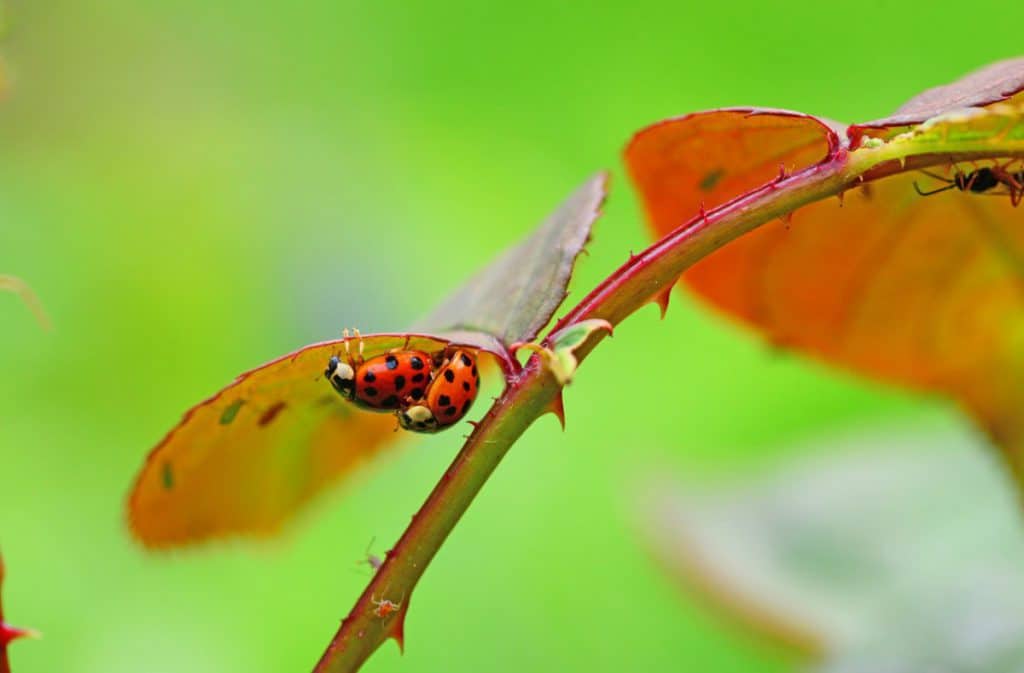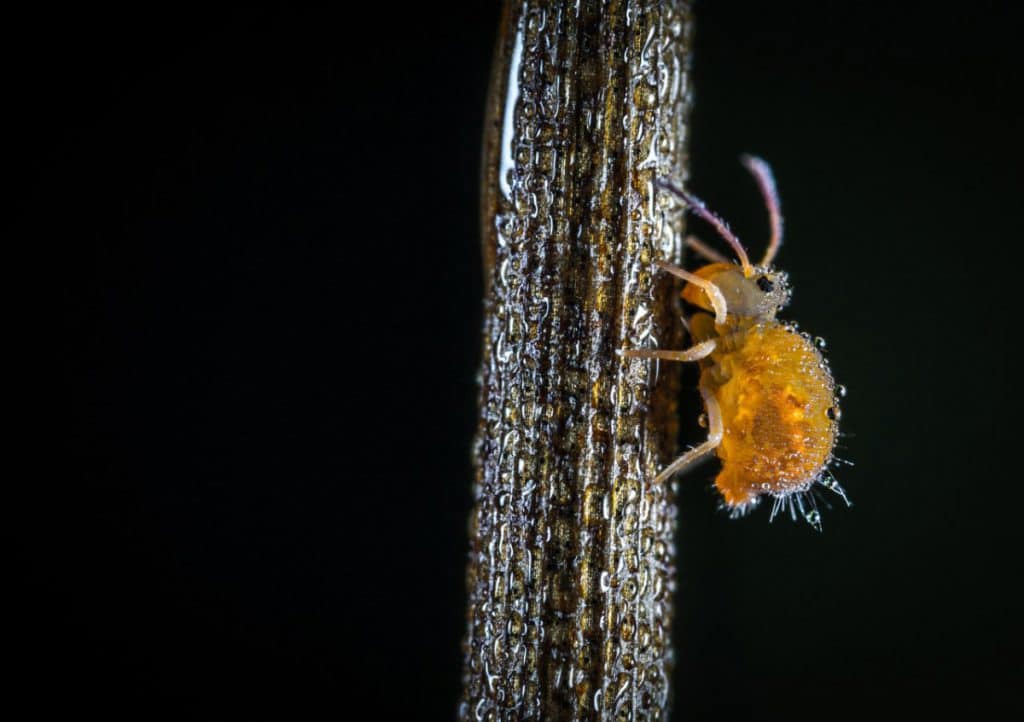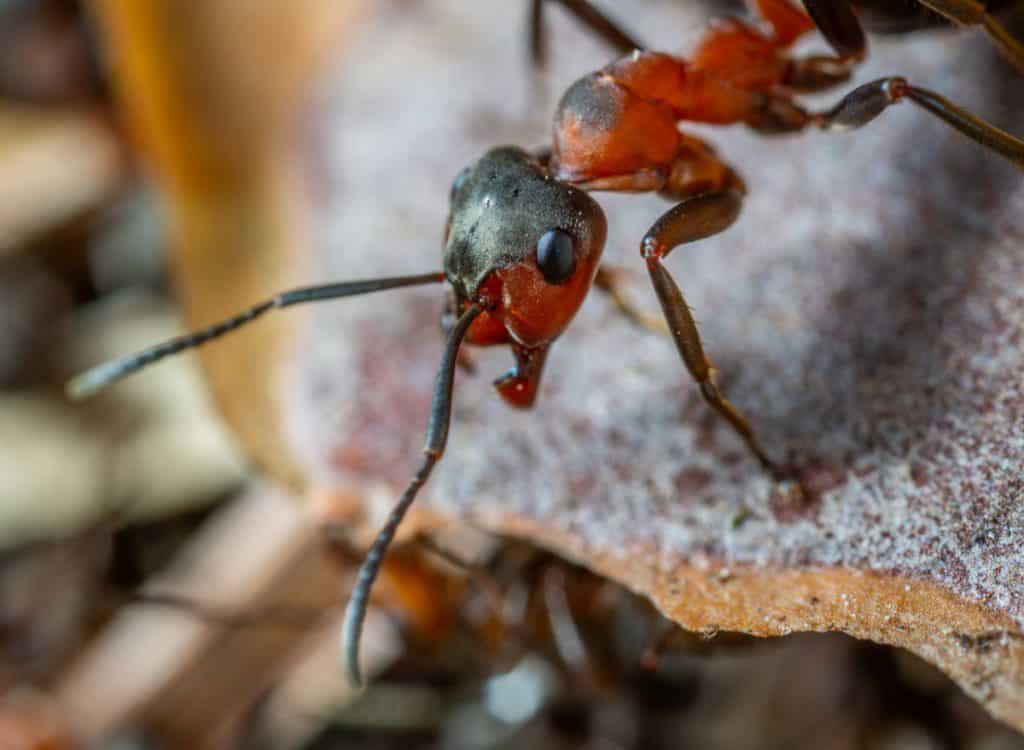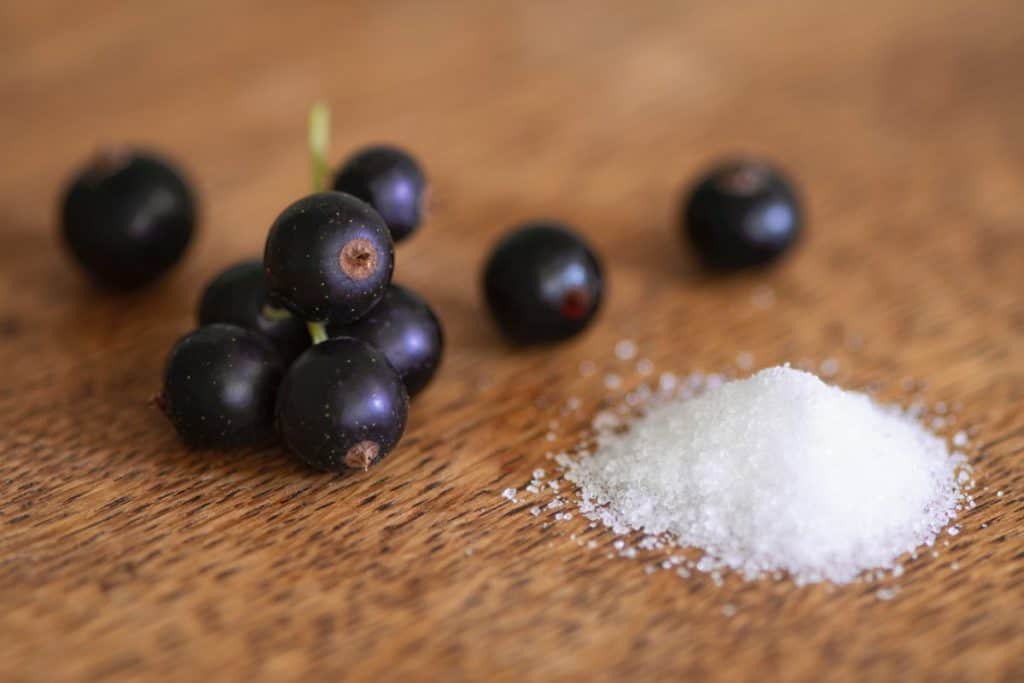
If you enjoy reading this article, why not check out our articles on What Can Ladybugs Damage? The surprising answer and Can You Keep Ladybugs As Pets?
What Are Ladybugs?
Ladybugs, also known as the Coccinellidae, are insects that are part of the beetle order called Coleoptera. They are usually characterized by their oval-shaped bodies and different colors. They are known by different names such as ladybirds and lady beetles. Ladybugs are the favorite of gardeners and farmers because they love to eat pests on plants. Just like any insects, ladybugs eat different types of food for them to survive. This article will tackle the different food that ladybugs eat in their daily lives.
What do you feed a ladybug?
There are more than 5,000 different ladybug species and not all of them eat the same food. They eat fruits, soft-bodied insects, and plants. However, the ladybug’s favorite food is aphids which can be found in different plants. Ladybugs’ love for aphids is very useful if you’re a gardener! To learn more about bugs and your garden, you may want to read Everything you need to know about Bugs and Your Garden.
Soft-Bodied Insects
Soft-bodied insects are usually small, delicate, and fragile. Some soft-bodied insects including aphids, mealybugs, and many immature stages of insects, such as,
- maggots
- white grubs
- caterpillars
Soft-bodied insects are probably the ladybug’s favorite food to eat. They eat about 5,000 insects in their lifetime, which is one year. Ladybugs are the most natural pest control that anyone can have in their garden or farm. This makes them the best friend of farmers and gardeners.
Aphids

As per Wikipedia, aphids are small sap-sucking insects and members of the superfamily, Aphidoidea. Common names include greenfly and blackfly, although individuals within a species can vary widely in color. Aphids are considered to be the main food of ladybugs.
What happens if you eat an aphid?
Aphids are serious pests of plants that ladybugs really love to eat, even larval ladybugs eat aphids. These soft-bodied yellow to red and black insects love to munch on your plants. These little critters have a white, wooly coating, and lives by sucking on the juices of the new growth on plants.
There are also some aphids that contains a substance that is much more toxic than other ladybugs. Due to this toxic substance that aphids have, it tends to kill the ladybugs. However, this does not happen as often since there are just a few numbers of aphids that contains a toxic substance.
Ladybugs also mate and lay their eggs close to aphid colonies, so that they can have continuous food supply for their offspring. They usually eat 5,000 aphids during their short lifespan and eat at least 475 aphids in a day.
Ants

What bugs eat ants?
There is some misconception that ladybugs eat ants, however, they do not eat ants. They prey the same soft-bodied insect which is aphids. In their daily lives, they fight over aphids. Ladybugs eat aphids while ants farm for them. Ladybugs usually ignore ants whenever they meet paths.
Do ladybugs kill other bugs?
However, ladybugs will defend their aphids once they notice ants coming. Ants and ladybugs to do not ‘attack’ each other whenever they feel threatened. When a ladybug feels outnumbered by ants, all they would do is fly away. The same thing will happen when an ant feels outnumbered, they would just look for an exit. If you’re interested in learning more about what ladybugs do when they’re threatened, take a look at What Can Ladybugs Damage? The surprising answer.
Even though they feel threatened, ants and ladybugs would never have a conflict or fight over their food. Ants tend to farm together which makes the ladybugs uncomfortable and they would look for another place where they can eat their aphids.
Spider Mites
As per Wikipedia, spider mites live on the undersides of leaves of plants, where they may spin protective silk webs. They can cause damage by puncturing the plant cells to feed. Spider mites are known to feed on several hundred species of plants.
Spider mites’ webs are usually found at the internodes of plants, crippling in the new side branch growth. You will see some leaves that are twisting and when you look at the underside of the leaf, a lattice of webs is present. This means that you are dealing with spider mites in your farm or garden.
Stethorus punctum is the type of ladybug that eats spider mites in their daily lives. Ladybugs can eat at least nine spider mites an hour or 75 to 100 per day. Aside from the aphids, this is one of the soft-bodied insects that ladybugs love to eat.
If you are taking care of ladybugs at home, spider mites are usually the number one food that you would buy for them to eat. You can buy spider mites in pet or online stores to feed your ladybug. Before you do so, you have to make sure the species of the ladybug that you have at home.
Not all of the ladybugs eat the same food, where some ladybugs are vegetarians and feed on plant leaves.
Ticks
As per Wikipedia, ticks are arachnids, typically three to five millimeters long. They are part of the order called Parasitiformes. These types of insects usually live by feeding on the blood of mammals, birds, and sometimes they feed on reptiles as well. They are usually present in warm and humid climates.
benefits of Ticks
Ticks have the same benefits as aphids and spider mites when it comes to food for ladybugs. They like these types of insects because they are small and soft, which makes them easy to eat. Ladybugs can eat at least 60 ticks a day.
Ticks are not usually the number one food that ladybugs eat but when they encounter ticks, they will eat them. This is because they are soft-bodied insects that they usually love to eat.
Bed Bugs
Everyone is familiar with the saying, ‘Don’t let the bed bugs bite!’ before going to bed. Bed bugs are insects that feed on human blood, usually at night. Their bites can result in skin rashes, psychological effects, and allergy symptoms.
Bed bugs are one of the many soft-bodied insects that ladybugs eat. However, ladybugs cannot eat the full-grown bed bugs because of their size. They are capable of eating the baby and nymphs. Ticks are not the first choice of ladybugs, however, they still enjoy eating them.
Thrips
As per Wikipedia, thrips are slender insects with fringed wings and unique asymmetrical mouthparts. These insects usually feed on plants by puncturing and sucking up the contents of the plant. Thrips usually take the life out of the plants since they suck the content of the plant.
Thrips usually pest on plants in a large group, however, when they are disturbed they usually leap and fly away. These insects host plants which include onions, beans, carrots, squash, and many other vegetables as well as flowers.
Catching these insects may be a bit difficult for the ladybugs because they tend to leap and fly away when they feel threatened.
Fruits and Sugar

Many people think that feeding fruits and sugar to ladybugs are dangerous. However, they are wrong. There are certain fruits that ladybugs love to eat. It is also safe to feed them fruits as long as they are non-acidic fruits. This practice is great for those who would like to take care of ladybugs in their homes.
While the main food of ladybugs is aphids and soft-bodied insects, they also feed on fruits and anything sweet. Fruits with high sugar content and non-acidic fruits are the ladybug’s favorites. Some examples of fruits that they eat are bananas, dates, figs, grapes, papaya, and persimmons. However, their favorite fruits are grapes because of their high sugar content.
Low acidic food that you can feed ladybugs are apples, blackberries, blueberries, cherries, grapes, nectarines, peaches, pears, plums, and raspberries. You can also feed them raisins that are soaked in water.
The safest food that you can give a ladybug are strawberries and rehydrated apricot and raisins. Aside from these fruits, it is also safe to feed your ladybugs, honey. Mixing dime-sized blob of honey with two to three drops of water inside a bottle cap.
However, you would need to do a little research on what ladybug you have at home. Some ladybug species do not eat fruits. Some ladybugs only eat insects and some ladybugs are vegetarians and feed on leaves and other plants.
Plants
Aside from fruits and soft-bodied insects, some ladybugs eat plants. These vegetarian ladybugs, also known as Epilachninae, eat plants and flowers. They also feed on pollen on a few selected plants.
Aside from plants and flowers, they also like to eat fungi like mushrooms and mildew. These types of ladybugs tend to be pests and can sometimes be the reason why plants die. Here are a few plants that ladybugs are attracted to.
Garlic
Garlic flowers are great in attracting ladybugs. It is easy to cultivate and it’s not fussy to plant. This plant is also great in repelling pests and insects like flies and mosquitoes.
Bachelor’s Button
This flower is also known as the “Blue Button” or “Corn Flower”. It is great in attracting ladybugs and other pollinators because of its blue color. Bachelor’s Button also comes in white and pink color. These flowers are easy to grow and low maintenance.
Calendula
Calendula flowers usually bloom during summertime and the flowers are edible. These flowers are easy to grow and are known for their soothing properties. Ladybugs are attracted to these flowers because they love to eat its pollen.
Geranium
These flowers attract ladybugs due to its scent and pollen. These plants are easy to maintain and it also repels away mosquitoes and other bothersome insects. Aside from ladybugs, these plants also attract butterflies and moths.
Dill
Now, we know that these plants are usually used in cooking. However, it also attracts ladybugs and other pollinators. It is best to grow dill with vegetables and other flowers in your garden.
Sweet Alyssum
Sweet alyssums are flowers that usually bloom in clusters during summer. The mild fragrant that it releases attract the ladybugs.
Cilantro
Just like dill, cilantro is not just an herb that you put on your cooking. The smell of cilantro also attracts ladybugs. It is easy to grow in your garden, and it is also low maintenance.
Parsley
Parsley also attracts ladybugs because of its umbel shaped plant. It is the most common herb and it’s easy to grow in your garden.
Mint
Mints are easy to grow, and it is used when you are cooking. These are also great in preparing infusions and drinks that you can make during summer. Due to its aroma, ladybugs are attracted to it and tend to feed on its leaves.
What plants do ladybugs eat?
These are just a few of the plants and flowers that ladybugs are attracted to and eat in their daily lives. Now, if you have plants that have a lot of pests such as aphids, planting these types of plants or flowers near them would be great.
If you have a ladybug that is vegetarian, you can always feed them lettuce. It is nice to have at least half a leaf and tear them into small pieces where you can leave the ladybugs to graze inside their cage. Just like any animals and insects, they would need water to survive as well.
Do ladybugs need water?
As a source of water, you can place a damp paper towel or sponge inside your ladybug’s cage. Wet the paper towel or sponge thoroughly, and wring the excess water. Now, ladybugs do not drink a lot of water, and this would suffice them for days.
Conclusion
- There are a lot of different species when it comes to ladybugs. Not all of them have the same diet.
- Some ladybugs eat soft-bodied insects such as aphids, spider mites, ticks, and bed bugs.
- The Epilachninae, which is a type of ladybug, are vegetarians and only feed on leaves of flowers and plants.
- If you plan to take care of ladybugs in your home, feeding fruits are the right way to go. You just have to make sure you give them nonacidic fruits.
- Ladybugs are more attracted to fruits that have high sugar content. Their most favorite fruit is the grapes because of their sugar content.
- Knowing the right food to feed your ladybug is great for them to live their full life!
If you enjoyed reading this article, why not check out our articles on Do Ladybug Spots Tell Their Age? and The Color of Ladybugs – Explained
Recent Posts
Tiny Black Bugs in Bathroom NO WINGS: What They Are and What to Do!
Finding tiny black bugs in your bathroom can be uncomfortable, to say the least. Especially if they are persistent, or they appear in very large numbers, which they often like to do. When it...
Tiny Black Bugs in Plant Soil - What Are They & What To Do About It
A short horror story: You get a new houseplant. You do your best to take care of it. You’ve ensured that it has the right soil, the right amount of sun, it gets enough water. And then one day, you...

